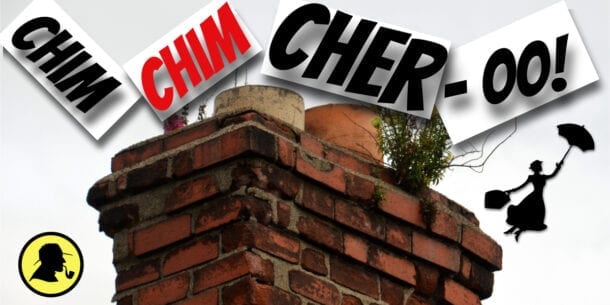Should unused chimneys be capped if your no longer going to use them for a real fire again?
In short YES, There are many factors to why you should cap off a unused chimney, but it has to be done properly and just not blocked off at the top of the stack.
Why Should Unused Chimneys Be Capped?
Capping a chimney has it’s benefits if your no longer going to use it, the main benefit is the thermal efficiency it will give your home.
This will cut your heating bill right down instead of heating the street.
It will also stop any birds or insects nesting inside the chimney stack or becoming stuck and dying (such a shame)
…But the most IMPORTANT reason, it will stop any water collecting inside the stack.
The moisture from the rain will run down the internal brick work which can easily enter the attic and also collect at the bottom of the chimney breast.
Consider a bad winter, the chimney isn’t capped, the bricks inside the breast will eventually get saturated from the rain.
Which will leak into the internal walls causing damp stains/odors etc, a problem you really don’t want.
How Do You Cap An Unused Chimney?
There are so many different options nowadays to cap off an unused chimney.
One of the best ways (in my opinion) is to use a Chimney C Cap

Chimney C Caps are a plastic terracotta cap with an bird/insect guard that sits in side the cap.
Spring loaded legs are fitted securely to the base of the cap which allow the cap to be securely fitted to the chimney pot.
They come flat packed when purchased and are easily assembled within 5 mins (but make a cuppa first!).Once assembled they look like this…

The spring loaded legs provide tension against the inside of the chimney pot, so no external fixings are needed.
I find this such a nice feature because they don’t attract any attention with any big ugly brackets, very inconspicuous.

Because of the way the C Cap fits, it provide sufficient ventilation for your chimney breast, but also keeps heat loss to a minimum (very important).
Once the C cap is assembled it literally takes seconds to fit, once your on top of the roof.
A huge benefit of the C cap, it easily allows you to reopen the chimney in the future if you ever wanted have a log burner.
The Chimney C Cap comes in two different sizes:
A standard size cap which covers outside diameter chimney pots between sizes 200mm & 280mm can be found on Amazon.
And a large cap which covers outside diameter chimney pots between 250mm & 330mm, can be found on Amazon.
Capping a Chimney Off With a Slab
Capping a chimney off with a slab is, well, not may favorite at all.
The only time this method should be used is if the the chimney needed a reduction in height or the corbelled brickwork becomes loose.

But if the chimney gets to this point I would really consider having the stack removed completely or consider having it fully repaired and capped off with a C Cap.
Using a slab to cap off the chimney also makes it a costly repair if you ever wanted to reuse the chimney again in the future.
It could also cause some haggling over the sale price of your house if the buyer realise the chimney is capped of permanently and they have plans to install a log burner.
They also look very ugly and eventually let the water back into the chimney stack once the mortar lines fail.
Ventilation bricks have to be also fitted just below the cap, which, if not done right, looks even worse!
Does a Capped Chimney Need to Be Vented?
Other than asking should unused chimneys be capped, fitting a vent is just as important
A chimney needs a vent, not just at the top (provided by the cap) but also at the bottom.
When you brick up the fireplace you need to fit either an air brick or a plastic/metal vent to allow air flow through the stack.
The air flow helps keep the chimney dry and ward off any condensation forming inside the stack.
If there is no air flow, condensation will form inside the stack and will be soaked up by the old coal soot.
This will eventually saturate the brick and cause damp patches forming on the plastered wall that surrounds your chimney breast.
Be Careful…
If you decide to cap your chimney off yourself please make sure you use the correct ladder safety, especially when using a crawl ladder.
If your not confident enough by all means don’t attempt this repair, instead get a competent tradesman who knows what he is doing.
Also ask the tradesman to talk you through the process and make sure you ask if the chimney will still be vented.
if they say “NO” or “it doesn’t need a vent really”, avoid using them.
A capped chimney should ALWAYS be vented.
Did This Post Help?
Hopefully this post has answered your question, should unused chimneys be capped?
It’s definitely a must if you want to keep your house and internal walls in tip top condition.
Damp can be a serious issue if not taken care of, it effects your health, the structure of your home and the resale value.
Each and every week I put my heart and soul into providing you with great content to help with any DIY jobs around the home.
If you think this post could help someone you know, please share.

Other Helpful Maintenance Articles
How To Maintain Your House – The Spring Home Maintenance Checklist With spring around the corner it makes perfect sense to check what maintenance your house may need for the season and the coming months ahead
Bahco Hand Saw Review – Bahco 244p XT Hard-Point saw 22″ Find out if the Bahco 244p XT hard-point saw is a worthy addition to your tool box.
How To Paint Over Wallpaper, Is It Easy? How to paint over wallpaper is a simple process but there are steps you shouldn’t skip, find out what they are…


Useful information but I have an unused chimney that has a metal liner. Does the liner need to be removed before capping.
I would 100% recommend you remove the liner from the chimney.
Anybody you have round that does not remove the liner is not doing the job properly.
The liner will just obstruct air flow.
Make sure you put a vent at the bottom of the chimney.
You don’t have to put the vent on the inside of the house, you could always fit an air brick into the outside wall into the chimney stack.
This is from a visual aspect, but if it doesn’t bother you, a vent fitted on the inside of the house on the chimney breast is far easier to do.
Hope this helps 😉
I took a stack down below roof height and roofed over it, so it is now only open to the loft space. Do I still need to vent the fireplace below or can I seal it off?
Hi James, you should still vent the chimney from the bottom, you don’t necessarily have to have the vent in the house, you could always knock a brick out on the exterior wall and put an air brick in, or use an SDS and drill several holes into a brick and then cover with a louvre vent.
So seal off the fireplace and put vent on the outer wall of the stack to stop any heat from downstairs escaping into your loft.
There has always been an argument that if there is no movement of air in the stack that no ventilation is needed, the other arguments is the condition of the inside of the chimney from previous use will still have tarry deposits on the internals of the stack which require ventilation.
So you see, venting the stack, is best to be on the safe side…..Sorry for the long winded reply, but I hope it helps 😉
I’m want to decommission a chimney that has louvre pot & liner. Is there a way to cap a louvre pot, or should I get it removed?
Hi Ben, to my knowledge their isn’t a cap made for Louvre pot, so I’m afraid you will have to get it removed. I’ve also just had a quick look on eBay on the sold items option and a Louvre pot sells for an average of £50. So once it’s removed get it on ebay 👍